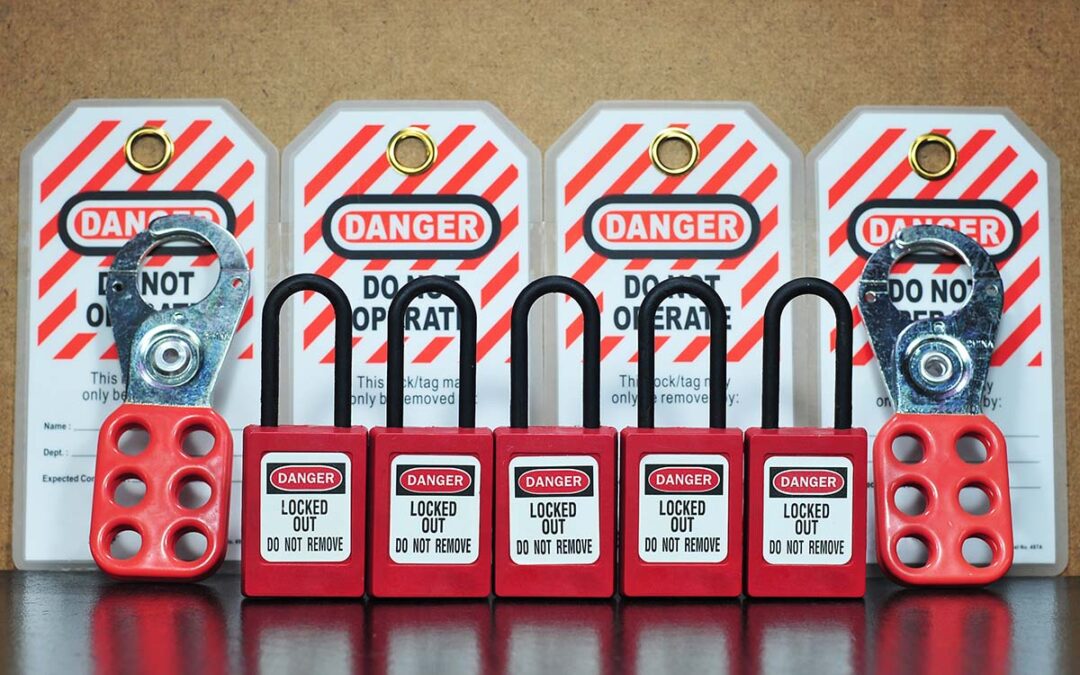Proper LOTO procedures are an OSHA-required safety measure for facility owners and managers. Safety Consultants USA’s specialists work directly with maintenance personnel and machine operators to document every energy source, isolation point, and verification step, ensuring OSHA compliance and practical usability. Our systematic approach helps prevent workplace incidents while protecting companies from the operational and financial impacts of safety-related shutdowns.
What is Lock Out Tag Out (LOTO)?
Lock Out Tag Out (LOTO) is a critical safety practice that protects workers during equipment maintenance and servicing. At its core, LOTO involves de-energizing machinery and equipment to prevent the unexpected release of hazardous energy during maintenance operations. As part of standard Control of Work procedures, LOTO serves two primary objectives: protecting workers from energy-related accidents and preventing unexpected equipment startup during maintenance activities.
Understanding Hazardous Energy Sources
In industrial settings, workers encounter various types of hazardous energy that require careful control. These energy sources include electrical, pneumatic, hydraulic, chemical, mechanical, and thermal energy. Each type presents unique risks that can result in serious workplace injuries if not properly controlled.
Inadequate energy control can lead to severe consequences, including electrical shocks, thermal burns, crushing injuries, amputations, and fatalities. If not properly managed, high-pressure air systems can result in serious injuries such as air embolisms, eye damage, and hearing loss due to pressure surges.
Hydraulic systems also pose risks, particularly from high-pressure fluid injection injuries, which can be life-threatening and cause extensive tissue damage if not treated promptly.
Electrical injuries are particularly hazardous, especially from arc flash and arc blast incidents. Arc flashes can produce temperatures as high as 35,000°F, resulting in severe burns, vision loss, hearing damage, and even fatalities. The sudden energy released during an arc flash can also cause explosive blasts, leading to severe injuries from flying debris and intense heat exposure. Electrical shock injuries further increase the risk of disrupted cardiac rhythms, nerve damage, muscle injuries, and long-term neurological issues.
Moreover, inadequate lockout/tagout procedures can expose workers to the risk of unexpected machinery start-ups, which can cause crushing injuries, amputations, or death.
Regulatory Framework and Standards
OSHA’s regulatory framework for LOTO consists of two standards. The primary standard, 29 CFR 1910.147, covers Control of Hazardous Energy requirements, including energy control program mandates and procedure documentation requirements. The electrical standard, 29 CFR 1910.333, explicitly addresses electrical safety requirements, circuit and equipment protection, and electrical-specific LOTO procedures.
These standards apply across general industry and construction sectors, emphasizing facilities operating equipment with multiple energy sources. Manufacturing and chemical processing facilities, especially those with machines having two or more energy sources, typically require the most comprehensive LOTO programs.
Developing and Implementing Energy Control Programs
A successful LOTO program begins with detailed, equipment-specific written procedures. Our safety professionals work directly with competent personnel who operate the machinery to develop these procedures. This collaboration ensures all energy sources are identified, and proper shutdown sequences are documented.
The process involves a thorough assessment of each machine, including:
- Identifying all energy sources (electrical, pneumatic, hydraulic, etc.)
- Determining proper shutdown sequences
- Documenting specific control points like breaker locations and valve positions
- Establishing verification methods to ensure zero energy state
- Accounting for specific hazards like thermal cool-down periods
The Six-Step Lock Out Tag Out Process
The standard LOTO procedure follows a six-step sequence that ensures comprehensive energy control:
- Preparation involves communicating with affected workers and gathering necessary tools and equipment.
- The shutdown phase follows manufacturer-specified procedures for powering down the equipment.
- Workers disconnect or separate all energy sources during isolation, including electrical disconnects and pneumatic lines.
- After isolation, workers apply their personal LOTO devices – standardized locks and tags. Most facilities use specific color-coding systems to help facilitate who has locked the machine out for maintenance.
- The stored energy check involves verifying zero energy state, such as checking pressure gauges for pneumatic systems.
- Isolation verification confirms the equipment cannot be restarted, typically through attempted routine startup procedures.
After isolation, workers apply their personal LOTO devices – standardized locks and tags. Most facilities use specific color-coding systems, with maintenance personnel often assigned red locks. The stored energy check involves verifying zero energy state, such as checking pressure gauges for pneumatic systems. Finally, isolation verification confirms the equipment cannot be restarted, typically through attempted routine startup procedures.
Personnel Classifications for LOTO
LOTO programs classify workers into authorized, affected, and awareness levels.
Authorized employees, typically maintenance personnel, receive comprehensive training in performing LOTO procedures.
Affected employees, such as machine operators, learn about LOTO procedures relevant to their equipment but don’t perform the actual lockout.
Awareness level training covers basic LOTO concepts for all other facility personnel.
Lock Out Tag Out Training Requirements
Training includes both classroom instruction and hands-on demonstration. Authorized employees must demonstrate proficiency in following lockout procedures on their specific equipment. Special situation training covers group lockouts, shift changes, and contractor coordination. Emergency procedures are also covered, including response to equipment malfunctions or accidents.
LOTO Program Maintenance and Compliance
OSHA requires annual inspections of LOTO procedures to ensure they remain current and effective. These reviews verify that procedures match current equipment configurations and that all energy sources are correctly identified and controlled. Documentation must be maintained for both methods and training records.
Many facilities engage Safety Consultants USA to develop and maintain their LOTO programs, ensuring procedures remain compliant and effective. These professionals can provide template-based documentation systems and conduct periodic reviews to identify any necessary updates or modifications to existing guidelines.
If you need training or documentation for your LOTO procedures, contact us today.
Frequently Asked Questions
What is the OSHA regulation for lock out tag out?
At its most basic, the regulation requires turning off machinery so it cannot be restarted during maintenance operations.
How often are lockout tagout procedures required to be audited or reviewed?
Loto programs should be reviewed annually and then periodic inspections completed annually on the procedures as well.
How long is a lockout tagout certification good for?
While there isn’t a specific LOTO certification, training should be renewed annually as a best practice.
Does OSHA 10 cover lockout tagout?
While OSHA 10 provides broad safety training, you should consult your OSHA training provider about specific coverage of LOTO procedures in their curriculum. Regardless of OSHA 10 coverage, companies must provide detailed, site-specific LOTO training for their employees based on their actual equipment and energy control procedures, particularly for authorized employees who will perform lockout procedures.





